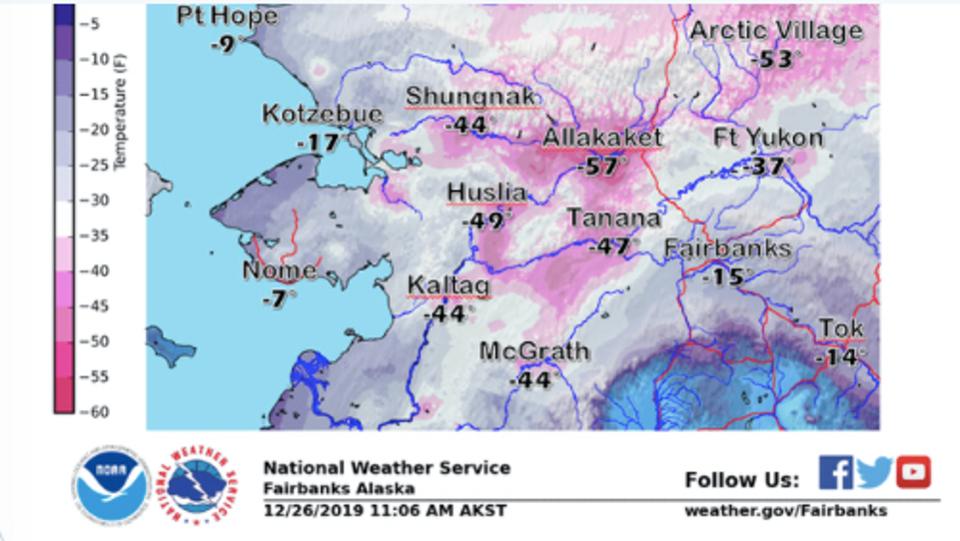Matthew Cappucci is an outstanding meteorologist and writer for the Washington Post Capital Weather Gang. Earlier this week, he wrote an excellent piece about the extremely cold temperatures in Alaska. A key message was even though parts of Alaska plummeted to colder than -50 deg F this week, the state is still on pace for its warmest year on record. I have often joked that because climate is warming, it is often “breaking news” when places that are supposed to be really cold are actually, well, cold. Is this extremely cold weather newsworthy or not and how unusual is it?
Temperatures in Alaska on December 26th, 2019.
It is absolutely newsworthy and meteorologically-interesting. Anytime I see -50 degrees F or colder on a map, it gets my attention. Coupled with frigid temperatures, the National Weather Service-Fairbanks has also issued Wind Chill Advisories for parts of interior Alaska through December 28th. They warn that “cold wind chills will cause frostbite in as little as 10 minutes to exposed skin….Expect wind chills to range from 45 below zero to 55 below zero.” The National Weather Service-Fairbanks discussion on Friday morning drives home the point:
Very cold temperatures are expected to continue through the weekend with a moderation of temperatures early next week. Areas where skies are clear in the Interior will see temperatures as cold as 35 to 55 below and generally 15 to 25 below where there is cloud cover.
Why is the interior region colder? According to the University of Alaska Climate Research Center website, “The Interior region of Alaska has a highly continental climate, with the warmest summers in the state, as well as the lowest record winter temperatures.” Interior regions tend to be removed from moderating influences of oceans and may also have significant elevation. AstroEdu’s website notes:
Regions of the Earth that have continental climates include Siberia and central Russia, and much of North America. Siberia, Canada and the northern states of the US in particular can exhibit very large differences – up to 40°C – between summertime and wintertime average temperatures.
Rock and soil have a lower heat capacity than water so lose or gain heat much more rapidly than water. This is why, for example, the water temperatures at a Georgia or north Florida beach may be cool in late May even though the sand is rather warm. Cloud cover also affects temperature. If the sky is clear, more heat (longwave infrared energy) can radiate away from the surface of Earth. As noted in the NWS Fairbanks discussion, temperatures were expected to be warmer under cloud cover, which absorbs and emits heat.
You still haven’t answer the question about whether this is “meh” or an extraordinarily unusual event Dr. Shepherd. Cappucci notes in his Capital Weather Gang piece:
How unusual is this?….Believe it or not, minus-40 or minus-50 lows in parts of Alaska are not as rare as you might think. But they are becoming less frequent

Record minimum temperatures in Alaska
The graphic above shows that record temperatures in this part of Alaska have been much colder at this time of the year. A 2016 National Academy of Sciences report on extreme weather attribution confirms the most “extreme cold events” are happening with less frequency or intensity, on average. The report ranked the level of confidence in science understanding of climate change linkages to different types of extreme events. This statement is telling:
The most dependable attribution findings are for those events related to an aspect of temperature, for which there is little doubt that human activity has caused an observed change in the long-term trend, the report notes. For example, a warmer climate increases the likelihood of extremely hot days and decreases the likelihood of extremely cold days.
This is consistent with a 2015 study in the journal Climate Change that also projected a decrease in the intensity and frequency of extreme cold events in the northern parts of the United States. Studies remind us that record highs and lows should be in relative balance in a normal climate system, but record highs are significantly outpacing record highs in the U.S.
The challenge for many people is that they misinterpret weather and climate. This extraordinary cold event is a perfect example of the difference between weather (your mood) and climate (your personality). Weather patterns this week were conducive to the cold event, yet the state of Alaska is still on pace to have its warmest year on record. Alaska-based climatologist Dr. Brian Brettschneider’s Tweet Friday morning sums it up:
With a record low temp at Bettles on both Dec 26 and Dec 27, here’s the new tally of records at major stations in Alaska in 2019: Record highs: 326 Record lows: 11 @AlaskaWx
It is also important to remember that even as climate warms due to anthropogenic influences superimposed on a naturally-varying system, we will absolutely still have cold events and snowstorms. The Earth periodically tilts away from the Sun as it goes around the star (Winter). We’ll always have seasons. Cold events and climate warming are counterintuitive concepts for many people. It is easy to oversimplify things as “cold” and “hot.” Unfortunately, the atmosphere is not that simple.
Brettschneider gets the last word with another classic Tweet, “Make Alaska Cold Again. #MACA”

Record temperatures in Alaska (November 2019)
